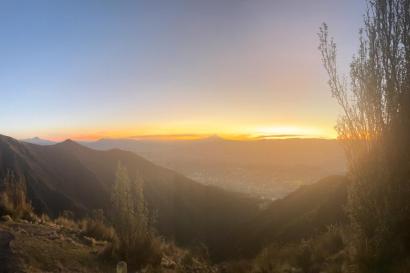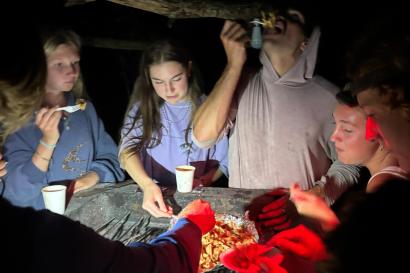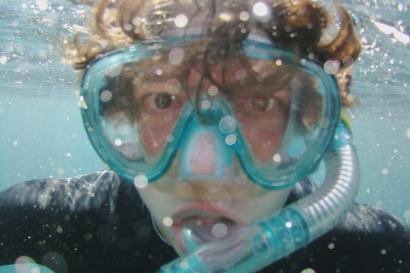Although my first class, called Wildlife Conservation Biology, lasted three weeks, only around five days within that span were actually in the classroom. As with most of the people in this program, I believe that the best learning doesn’t happen in a classroom, and I am so grateful that this philosophy is taken so seriously in my classes here.
Our first field trip lasted two days and was to the Santa Lucía Cloud Forest. Although it wasn’t very far from Quito by the way the crow flies, it was a process to get there. The cloud forest was just on the other side of the mountains from the university, and when we finally arrived, we had a two-hour hike up to our ecolodge while mules carried all of our bags. This was one of the most surreal places I have ever been, as clouds constantly surrounded and floated through us. As with everywhere in this country, we were able to see some amazing wildlife, including a green toucanet, tanagers, hummingbirds, a kinkajou, frogs, several million types of bugs, and many more. Deep within the forest they even had a garden dedicated to the many types of orchids of the cloud forest.
The next Monday, we left for the Tiputini Biodiversity Station in the middle of the Ecuadorian Amazon. Compared to our last trip, it was really a journey to get there. It took a plane ride from Quito to Coca, a boat ride up the Río Napo from Coca to an oil company checkpoint, a ride in a chiva (a type of open-air bus) up the oil company road (we were all very conflicted because we had learned about the harmful effects this road had caused to both the local Huarani people and the rainforest itself, yet we were benefitting from its existence), and then another boat ride up the Río Tiputini. The trip in its entirety lasted around eight hours, although I wouldn’t have wanted to do it in any other way. We spent every day hiking and observing this labyrinth called the rainforest and often took the boat up the river to different sites. In the brief five days that we were there, we came across captivating birds such as scarlet macaws, green parrots, dusky-headed parakeets, and toco toucans, at least five types of monkeys including howler monkeys and woolly monkeys, vipers, poison dart frogs, tarantulas, and much more. At one point in a hike, a guide broke a tree branch and asked us to eat the ants that came crawling out, and I can now say with certainty why these specific ants are called lemon ants. Also, everything was enormous. Even crickets were as big as my fist. I’m not going to say I enjoyed it, but as a person comfortable with seeing bugs, it was quite the sight to see people who had never spent time outdoors encounter spiders that looked like they’d eat your soul. In the end, I was sad to leave this practically undisturbed paradise, although I’ll be heading to plenty more in my time here.
The next week, we took a day trip to the Quito Zoo at Guayllabamba. Although it’s labeled a zoo, it is primarily a rescue center, and we were given a very informative tour of the realities of the illegal wildlife trade and how humans impact different animals. They had many different types of Ecuadorian animals, several types of which we had seen in the weeks before, and it was devastating to see how their behaviors are changed.
The day after, we visited the páramo (high-altitude grasslands) near the Antisana Volcano. We were shown how integral these areas were to the development of the Amazon Basin, and it was (surprise surprise) filled with wildlife. There were many birds such as the caracara, the black-faced ibis (which there are only 90 left of in the wild), the American kestrel, and the Andean lapwing, among others. We were also lucky enough to see ten Andean condors, which are the biggest birds in the world and whose numbers are rapidly decreasing. Additionally, there were rabbits, deer, and other small mammals. It was fascinating to compare this landscape with both the Amazon and the cloud forest. Even though they could be considered polar opposites, their importance and biodiversity are unlike no others.
I am convinced that this program and this country are just a remake of the Jim Carrey movie “The Truman Show” because there is absolutely no way that these places don’t exist anywhere that isn’t a movie set. I am stunned beyond belief no matter where I go, and I just wanted to write this here so later when I discover the truth I can say “I told you so.”

Thomas Hotaling
<p class="MsoBodyText" style="margin-top:.4pt; margin-right:21.05pt; margin-bottom:.0001pt; margin-left:5.5pt"><span style="line-height:103%">Hello! My name is Thomas, and I’m from St. Louis, Missouri and currently am a second year at Case Western Reserve University. I like to think of myself as an avid outdoorsman, and you can often find me backpacking or just having fun outside, and I’m even a summer camp nature counselor. I'm currently studying environmental geology because rocks are the absolute coolest, and if you don't believe me I'd be happy to share my opinions with you.</span></p>








